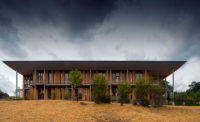While officially neutral on green-building rating systems, the American Institute of Architects (AIA) recently parsed three of them in an effort to evaluate how well they align with the association’s sustainability goals. In its report, which was released in May, it carefully avoided picking a favorite of the three systems: t he U.S. Green Building Council’s LEED NC 2.2, the Green Building Initiative’s Green Globes, and The International Initiative for a Sustainable Environment’s SBTool 07. The intent of the study was simply to assess their strengths and weaknesses, says Jessyca Henderson, an AIA staff architect. “The AIA is neutral,” she explains, “and therefore can leverage some credibility to a critique .”
The association has long promoted sustainable design, primarily through its 7,200-member Committee on the Environment (COTE), whose roots can be traced back to the 1970s. In recent years, the AIA has honed in on carbon emissions, urging reduction strategies that would lead to carbon neutrality in buildings by 2030. Three years ago, it put forth specific criteria that emphasized third-party verification, lifecycle analysis, strict land-use requirements, clear goal-setting, and post-occupancy assessments, among other things. Henderson says their overall agenda is to raise both the lowest common denominator and the gold standard among green building schemes.
The three rating systems were reviewed by the AIA’ s sustainability discussion group, which includes green building experts and AIA board members. The AIA listed 16 points that they encourage organizations to include in their rating systems, such as whether the standards are regularly renewed, require documentation of building performance, or promote renewable energy sources. Below are some of their findings on how each system matched up with the 16 criteria. The report also can be viewed on the AIA’s Web site.
The AIA assessed version 2.2 of LEED (Leadership in Energy and Environmental Design) for New Construction and Major Renovations, which was introduced in late 2005 and implemented on January 1, 2006. LEED-NC is organized into six categories with each one including prerequisites for achieving credit points toward certification—Certified (26-32 points), Silver (33-38), Gold (39-51), or Platinum (52-69). The categories are: sustainable sites (14 possible points), water efficiency (5), energy and atmosphere (17), materials and resources (13), indoor environmental quality (15), and innovation and design process (5), for a maximum of 69 possible points. For example, a building will receive one point if public transportation is easily accessible, or if over 50 percent of all wood-based materials and products are approved by the Forest Stewardship Council.
Overall, the AIA study found that LEED is a “good example of a rating system that provides a measurement of environmental achievement,” though the AIA recommends that the system uses life-cycle assessment data as a basis for design/construction decision-making. It suggests improvement in the renewable energy and carbon reduction targets for certified projects: while LEED-NC requires increased energy efficiency, it doesn’t specifically address reduction measures.
Green Globes
The Green Building Initiative’s Green Globes— a 1,000-point scale system—was released in October 2007 and is based on a building’s performance in seven areas: project management, energy, indoor environment, site, water, resources, and emissions. Projects are awarded a final rating of one (35-54 percent), two (55-69 percent), three (70-84 percent), or four (85-100 percent) globes based on cumulative points.
The report suggests that although this online scoring system involves third-party review for certification, it’s more flexible than LEED. Where the LEED system requires many of the AIA’s 16 points, the Green Globes standards simply “encourages” them. For instance, it has allowed the timber industry to push its Sustainable Forestry Initiative as an alternative to the more stringent Forest Stewardship Council certification. While Green Globes does feature a lifecycle-analysis application (unlike LEED), the AIA sees room for improvement in measuring energy efficiency and operational performance by setting specific goals for significant reductions in energy use.
SBTool 07
The SBTool 07, formerly GBTool, is an international, generic tool kit that was developed through the work of more than 20 countries. It allows local organizations to design their own rating system depending on regional climate zones, local building codes, and international standards.
Users add their own benchmarks and grade their own projects using the criteria of site selection, project planning and development, energy and resource consumption, environmental loadings, indoor environmental quality, service quality, social and economic aspects, and cultural and perceptual aspects. An independent assessor reviews the self-assessment, with weighted scores ranging from -1 (deficient), 0 (minimum acceptable performance), +3 (good practice), and +5 (best practice) for each category. The results are then sent to the headquarters of the International Initiative for a Sustainable Environment (iiSBE) for final certification.
While the SBTool 07 accommodates regional variations, the AIA cautions that the program’s flexibility could leave too much to the discretion of designers, particularly in regards to energy use and building performance. The study authors recommend an increase in the number of “required” items as opposed to those that are simply encouraged, especially with project documentation. The report also suggests that the rating system include more performance-based requirements to reach carbon-reduction goals.
Alanna Malone contributed reporting for this story.


